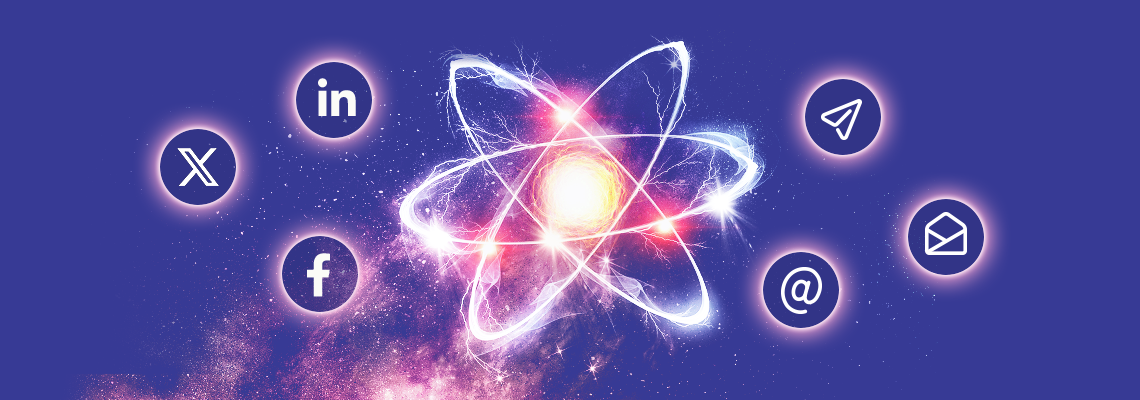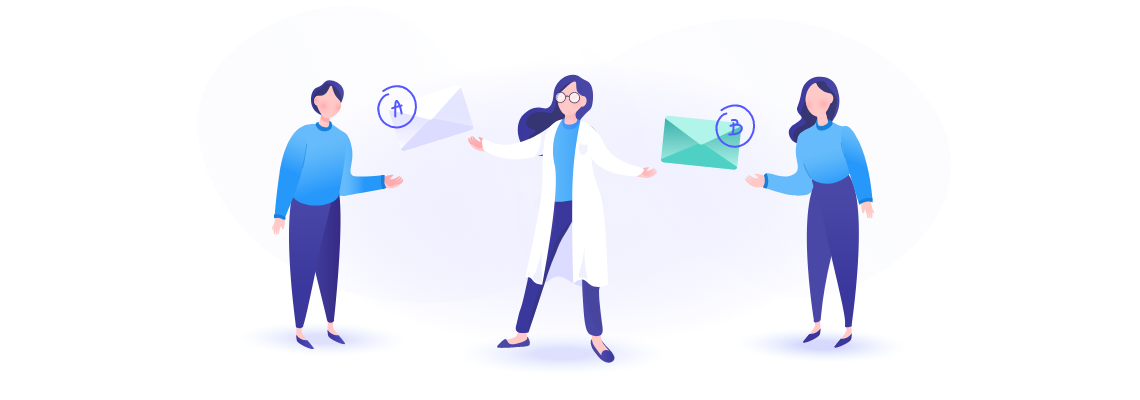Imagine a world where every business interaction feels like it's crafted just for you. Well, that's what customers expect today with 56% more likely to become repeat buyers after just one personalized experience. But how can you create this kind of customer journey? By embracing an omnichannel approach in your marketing strategy.
A vital part of this is email marketing —a potent tool delivering personalized magic directly to your customers’ inboxes. Think of it as your brand's personal messenger, quietly working behind the scenes to enhance the entire customer experience. It's the kind of tool that turns a regular interaction into a memorable connection.
In this blog, we're giving you the lowdown on the full potential of email marketing within your omnichannel strategy. Ready to elevate your marketing game? Let's get started.
Table of Contents
- What is Omnichannel Marketing?
- Benefits of Omnichannel Marketing
- How to Use Email in Your Omnichannel Market Strategy
- Final Thoughts
- Key Takeaways
What is Omnichannel Marketing?
Omnichannel marketing is a way to make sure your customers have a smooth experience with your business, no matter where they find you—on your website, social media platforms, in a brick-and-mortar store, or through email. It's all about ensuring the different ways your business talks to customers work together seamlessly.
In practical terms, it means sharing customer information across all these places so you can create a simple and personalized journey for your customers.
Let's see this in action, shall we? Suppose you work for a business offering a cloud call center solution. With an omnichannel strategy in place, a customer might learn about your service via an advert, and then click through to your website. Having reviewed your offerings, they send a query through email asking whether your software would work with their existing call center hardware. Then, they discuss further details over a call.
Omnichannel ensures you have a complete picture of their interactions, allowing your team to respond cohesively. They won't need to repeat information, and the experience remains seamless, no matter which channel they choose.
Omnichannel vs. Multichannel
Multichannel marketing involves reaching out to customers through various channels, but the catch is these marketing channels operate independently. On the flip side, omnichannel marketing brings all these channels together, working as a team to ensure a seamless experience. It’s a sound idea to consider using specialized online marketing platforms that help create cohesive promotional campaigns through omnichannel marketing.
Benefits of Omnichannel Marketing
In today's world, most brands have adopted an omnichannel approach. Why? Because today's consumers have seen it all, and they're super picky about who they let into their lives. So, here's why going omnichannel can be key to success:
A Better User Experience
As a marketer, your gig is to guide customers smoothly from "Hey, I've heard of you" to "I'm sold!" Every email, social media post, and ad should be relevant, feeling more like a personalized conversation. An integrated omnichannel strategy achieves this by leveraging customer data, technology, and personalized content.
Let's say you're an agency working on medicare marketing strategies. Your potential client starts her journey on your website, exploring various Medicare plans. She clicks on an informative blog post you shared on which plan is best for her, educating her about the plans. Later, she receives a personalized email with a discounted Medicare plan that suits her needs. Additionally, you could provide a custom QR code in the email, which, when scanned, directs her to a detailed page about the plan's benefits or to schedule a consultation. This approach not only avoids bombarding her with generic information but also creates a seamless, interactive conversation that speaks directly to her concerns and preferences. No, you're creating a conversation that speaks directly to her concerns and preferences.
Enhanced Customer Retention
Beyond guiding customers through a sales funnel, the real goal is long-term retention and customer loyalty. Those repeat customers bring in more revenue and are likely to convert others too. Omnichannel marketing provides compelling reasons for continued engagement.
For instance, after a high-ticket purchase from RealVNC, sending relevant articles about remote IT support can build a connection. It can also encourage customers to reach out for help, rather than abandoning your brand if they run into issues.
Enhanced Customer Data
In the age of data, having a grip on what your customers are up to is crucial. Tracking interactions across channels offers a broader understanding of customer behavior. With this information, you can tweak things to make their journey smoother, provide a more consistent experience, and even predict what they might want next.
Let’s say your marketing team is targeting people looking into buying a domain. When tracking customer interactions, patterns emerge. You find that customers love browsing articles during lunch, engage with social posts in the evening, and open emails late at night. Capitalizing on this data, you can tweak their experience. Lunchtime brings a push notification with fresh AI domains, evenings showcase success stories on social media, and late-night emails offer exclusive offers. The result? Higher customer satisfaction, an improved engagement rate, and an increased chance of sales.
How to Use Email in Your Omnichannel Market Strategy
Now, let's talk about email—a trusted buddy in your customer engagement journey. Email is a powerful way to get customers attention, with 99% of email users checking their inbox daily and nearly 21% of all emails sent are opened within the first hour of sending. So, with 77% of marketers seeing an increased engagement over the last 12 months, it should be a pretty big part of any marketing campaign.
Step 1: Personalize with Customer Data
Forge a relationship between email, data, and actionable insights. When users sign up for a cloud-based contact center, leverage email to collect valuable first-party data by requesting personal details from them. Integrating your email service provider with a Customer Data Platform (CDP) facilitates a smooth flow of information, enabling highly personalized email campaigns.
Imagine your customer signs up on your e-commerce clothing platform. Through a strategically crafted welcome email you not only express gratitude for them registering and joining your community, but you can also encourage them to share their preferences such as product categories, style and sizes. With this data integrated into your CDP, you now have everything you need to send out future emails that showcase their personal product recommendations and exclusive discounts on ranges they love.
Step 2: Let Behavior Steer Your Emails
With your customer data in hand, you can now draft email sequences triggered by your customer's actions. Did they leave items in their online shopping cart? Cue an email gently nudging them towards checkout. Did they engage with your customer service team? Follow up with an email, seeking customer feedback on the experience. Did they make a purchase? Send out a request for a review to help build your brand’s reputation.
Crafting an effective email outreach sequence tailored to your customer's behavior can significantly enhance your omnichannel marketing strategy.
Your emails can also be responses to events happening on other channels. Imagine a customer encounters a glitch while using your conversational AI for sales on your website. Frustrated, they take to Facebook to vent about the issue, tagging your brand. Your social media team responds, expressing genuine apologies for the inconvenience and assuring them that your tech team is on it. At the same time, you send out a direct email, providing step-by-step guidance on resolving the issue and offering a personalized discount on your services as a gesture of goodwill.
Step 3: Roll Out the Welcome Mat to Other Touchpoints
Leverage email's prevalence to introduce new communication channels. Encourage sign-ups for email and SMS simultaneously using SMS marketing platforms, invite email subscribers to download your app, or include links to live chat for timely customer support. By strategically incorporating these options, you can effectively generate leads using content, broadening your outreach, and creating a diverse network for customer engagement.
For instance, let’s say you work in the beauty industry and your customer has just bought an awesome new product. Sure, you could hit them with the usual order confirmation email. But why not take it up a notch instead by triggering a personalized follow-up through automated SMS marketing? This approach helps you stay top-of-mind while enhancing the post-purchase experience in real time.
In your email, you share fun video tutorials from influencers who have used the product they’ve just bought. You also suggest matching products from their shopping history and promoting your social media channels so that they can tag you along their beauty journey. This transforms them from a one-time buyer to a long-term, repeat customer.
Step 4: Implement A/B Testing
Now that you’ve laid the groundwork for a brilliant omnichannel strategy using email, it’s time to start building on it. Implementing A/B testing can help you to better optimize this strategy and lead to more, even happier customers.
A/B testing is all about trying out different variations of your email to see which performs better with your target audience. You can test out a number of things including subject lines, call-to-action buttons, content layouts and more. The aim of an omnichannel A/B test is to see which variation is better for guiding customers to another channel.
If you work for a sporting goods store, for example, and are curious about the best way to guide your customers to follow you on social media, you could test one email nudging them to join the sports community online, and another cheering them on to be part of the fan club. Using metrics like click-through rates and conversion rates, you may find that the second content is more effective. That means you can spend more effort on that going forward, leading to better results.
And don't forget the power of a well-crafted "thank you email" to express your appreciation for customer engagement and loyalty. It's a simple yet effective way to strengthen your relationship with your customers and keep them coming back for more.
Final Thoughts
So there you have it! Implementing an omnichannel marketing strategy all boils down to giving your customers a connected, smooth experience across all touchpoints. Email is a crucial component of this strategy, adding a personalized touch and delivering relevant messages to your customers' inboxes.
Remember, the goal isn't just a sale. It's about building customer relationships, improving retention rates, and creating seamless user experiences. By embracing the omnichannel experience, you're creating a brand that customers not only choose but advocate for.
Key Takeaways
- Omnichannel marketing creates a seamless customer experience across all touchpoints
- Benefits of omnichannel approach include: a better user experience, enhanced customer retention, and enhanced customer data
- Email marketing is a vital and potent tool within an omnichannel strategy, known for its ability to deliver personalized messages directly to customer inboxes and enhance the overall customer experience
- To effectively use email in your omnichannel marketing strategy, you should: personalize with customer data, let behavior steer your emails, roll out the melcome mat to other touchpoints, and implement A/B testing
- The overall goal of an omnichannel strategy is to build strong customer relationships, improve retention rates, and create seamless user experiences
Eager to put this knowledge to some use?








